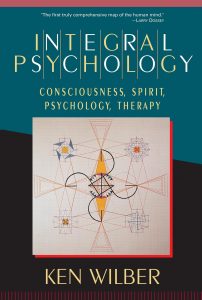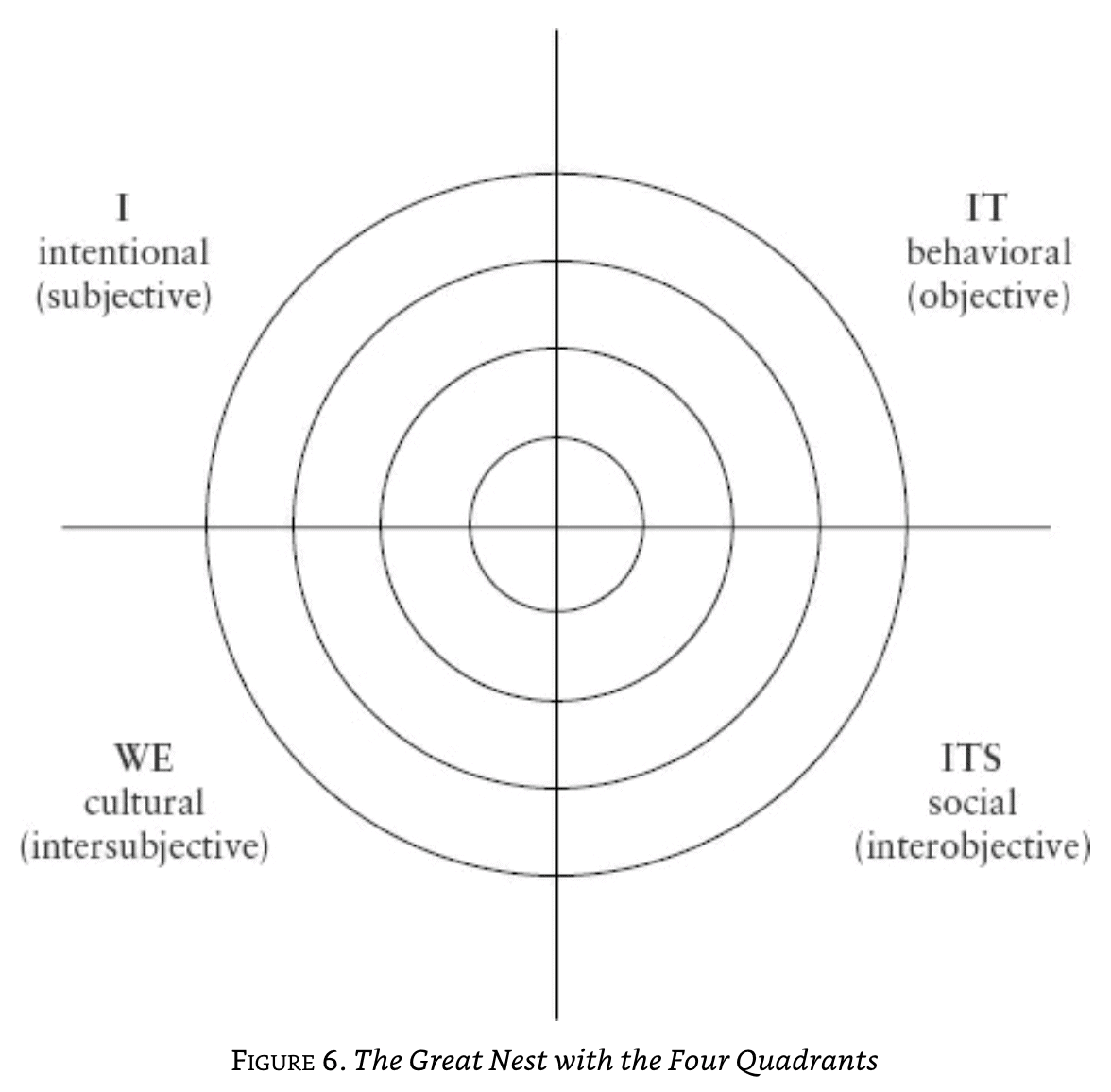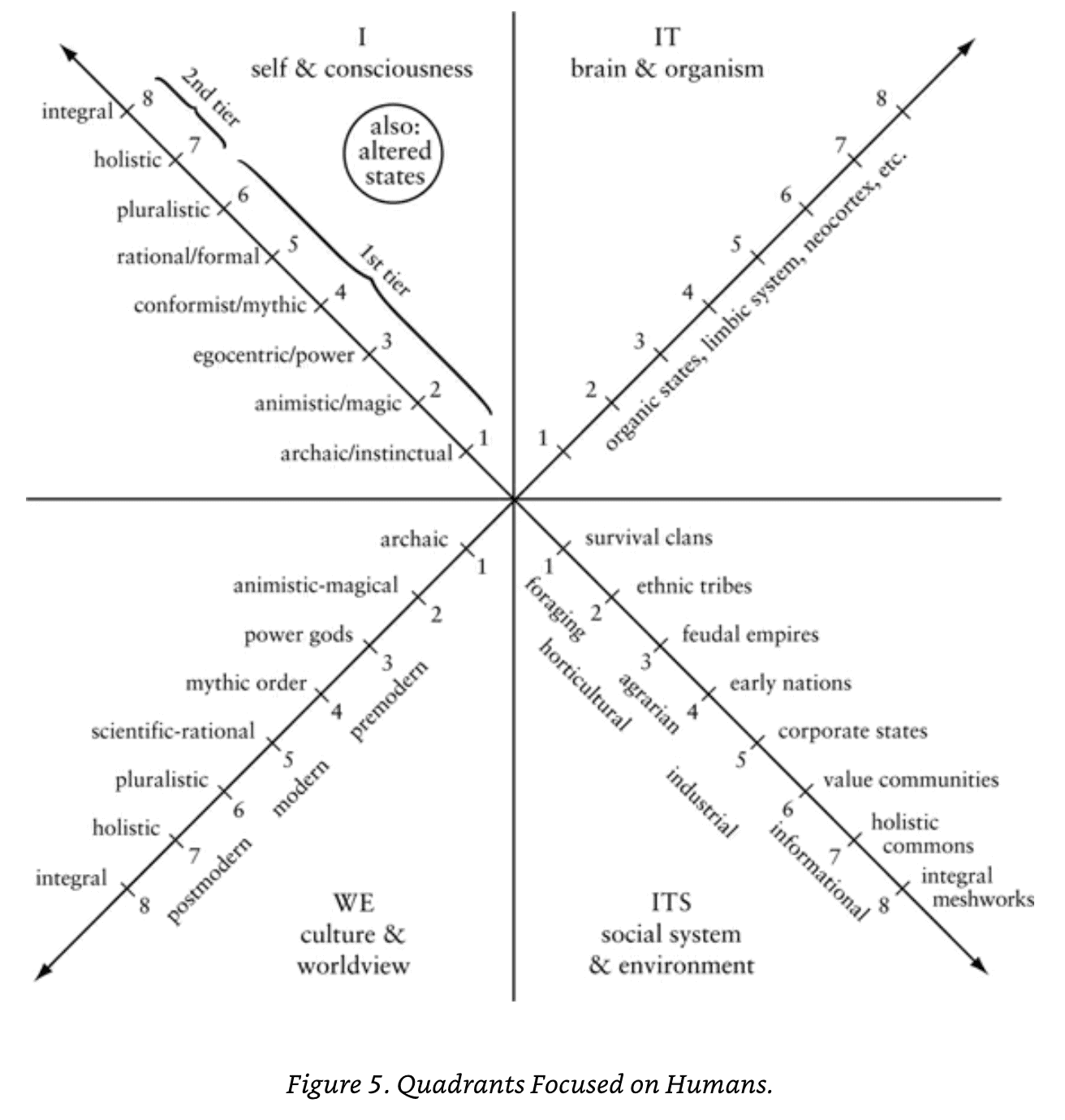This is a book summary of Integral Psychology: Consciousness, Spirit, Psychology, Therapy by Ken Wilber (Amazon).
🔒 Premium members have access to the companion post: Integral Psychology & Spirituality Synthesis: How to Develop Holistically (10+ Visuals)
Quick Housekeeping:
- All content in “quotation marks” is from the author (otherwise it’s paraphrased).
- All content is organized into my own themes (not the author’s chapters).
- Emphasis has been added in bold for readability/skimmability.
Book Summary Contents:
- About the Book
- Great Nest of Being
- Four Quadrants
- Stages & States
- The Self & Self-Development
- Maturity & Morals
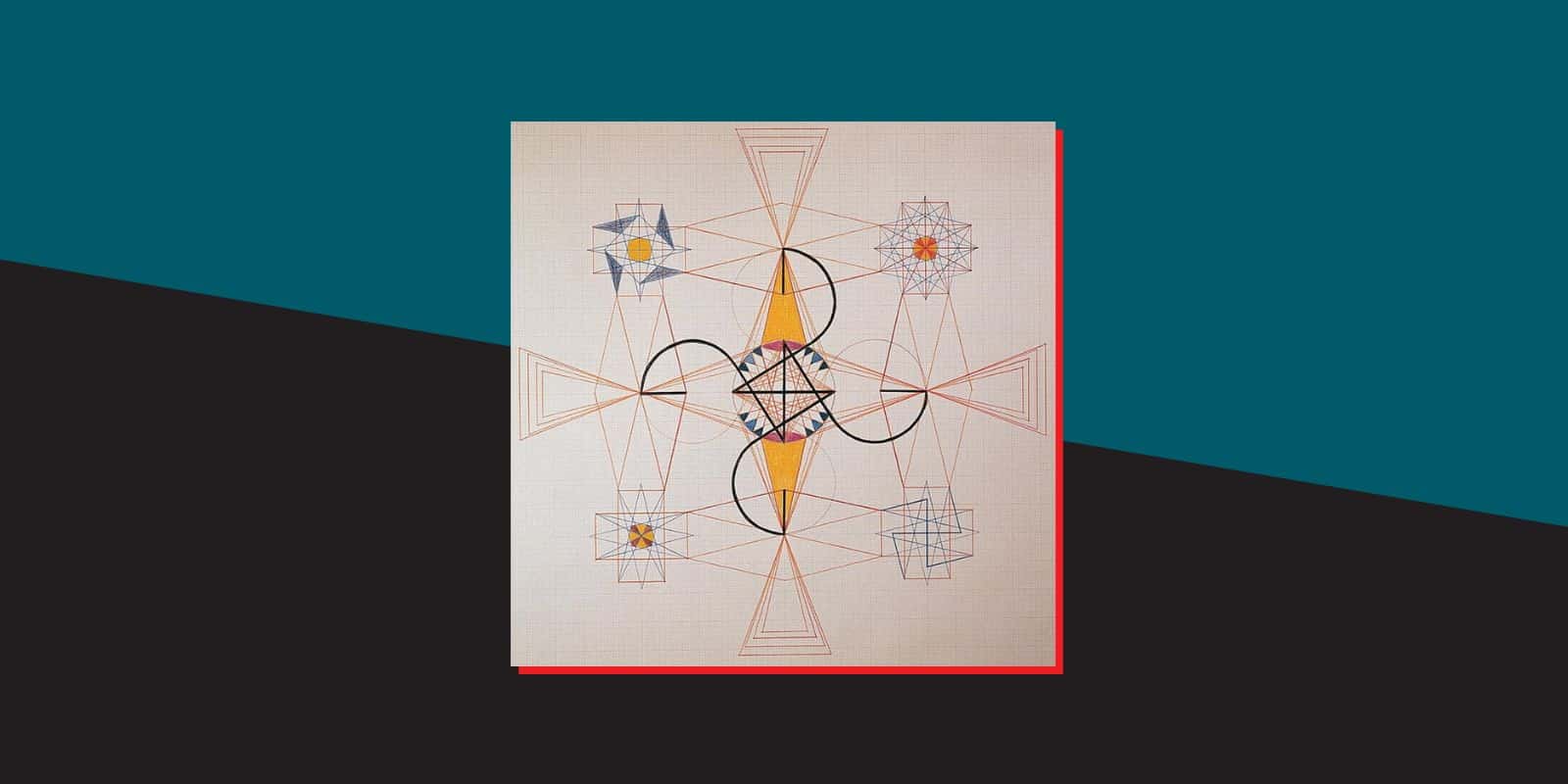
Holistic Human Development: Integral Psychology by Ken Wilber (Book Summary)
About the book Integral Psychology
“The goal of an ‘integral psychology’ is to honor and embrace every legitimate aspect of human consciousness under one roof. This book presents one of the first truly integrative models of consciousness, psychology, and therapy. Drawing on hundreds of sources—Eastern and Western, ancient and modern—Wilber creates a psychological model that includes waves of development, streams of development, states of consciousness, and the self, and follows the course of each from subconscious to self-conscious to superconscious.”
- “The great problem with psychology as it has historically unfolded is that, for the most part, different schools of psychology have often taken one of those aspects of the extraordinarily rich and multifaceted phenomenon of consciousness and announced that it is the only aspect worth studying (or even that it is the only aspect that actually exists).”
- “What if, on the other hand, all of the accounts were an important part of the story? What if they all possessed true, but partial, insights into the vast field of consciousness? At the very least, assembling their conclusions under one roof would vastly expand our ideas of what consciousness is and, more important, what it might become. The endeavor to honor and embrace every legitimate aspect of human consciousness is the goal of an integral psychology.”
- “‘Integral’ means, if it means anything, the integration of all that is given to humanity … The general idea of integral practice is clear enough: Exercise body, mind, soul, and spirit in self, culture, and nature. (That is, try to exercise the full spectrum in the I, we, and it domains.)”
A truly integral psychology would embrace the enduring insights of premodern, modern, and postmodern sources:
- The enduring truths of premodernity/perennial traditions: the Great Nest of Being.
- The good news of modernity: the differentiation of the value spheres—which means that each and every level of the Great Chain is differentiated into at least four dimensions: subjective or intentional, objective or behavioral, intersubjective or cultural, and interobjective or social—each with its own independent validity claims and equally honored forms of truth, from science to aesthetics to morals.
- The best of postmodernity: integration across all levels in the Great Nest (‘all-level, all-quadrant’)—this would take the best of ancient wisdom and integrate it with the best of modernity, while avoiding the downside of the ancient outlook (its lack of differentiation, pluralism, and contextualism) and the downside of modernity (its catastrophic collapse into flatland).
The major components (waves, streams, states, self, and self-streams):
- Levels/structures/waves in the Great Nest: matter, body, mind, soul, spirit.
- Developmental lines/streams: moral, aesthetic, religious, cognitive, affective, etc that move relatively independently through the great waves.
- States, or temporary states of consciousness: such as peak experiences, dream states, and altered states.
- Self: the seat of identity, will, and defenses, and which has to navigate, balance, and integrate all the various levels, lines, and states that it encounters.
- Self-related lines/streams: the developmental lines most intimately connected with the self such as the self’s central identity, its morals, and its needs.
Great Nest of Being
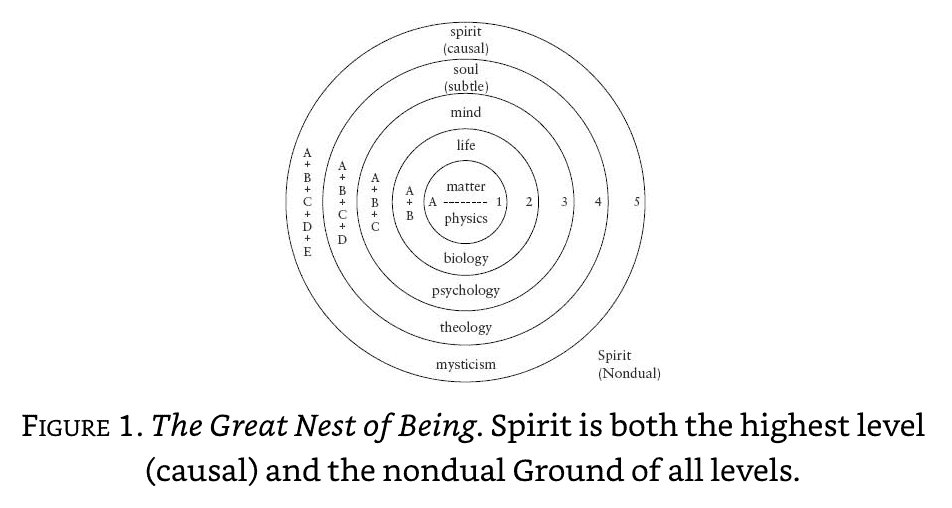
“The Great Nest of Being is the backbone of the perennial philosophy, and it would therefore be a crucial ingredient of any truly integral psychology … The core of the perennial philosophy is the view that reality is composed of various levels of existence—levels of being and of knowing—ranging from matter to body to mind to soul to spirit.”
Holons & Holarchies:
“The Great Nest is actually a great holarchy of being and knowing: levels of reality and levels of knowing those levels. That is, the perennial philosophers found both ontology and epistemology to be important, as inseparable aspects of the great waves of reality.”
- Holons: The universe is fundamentally composed of holons, wholes that are parts of other wholes. In short, the basic levels are the basic holons (stages, waves, spheres, nests) in the Great Nest of Being.
- Holarchies: Since each holon is embraced in a larger holon, holons themselves exist in nested hierarchies or holarchies. Holarchy includes a balance of both hierarchy (qualitatively ranked levels) and heterarchy (mutually linked dimensions).
- Example: A whole atom is part of a whole molecule, a whole molecule is part of a whole cell, a whole cell is part of a whole organism, and so on (nested hierarchy of increasing inclusiveness).
Transcend & Include:
“The basic levels in virtually every major system, ancient and modern, Eastern and Western, simply describe a vast morphogenetic field, or developmental space, and one that is migratory—it grades holarchically, transcending and including, nests within nests indefinitely, inviting a development that is envelopment.”
- Development is envelopment: A holon transcends and includes its predecessors (development that is envelopment). Each senior dimension in the Great Nest—from matter to body to mind to soul to spirit—envelops and embraces its juniors much like a series of concentric circles or spheres (this is a conception of wholes within wholes within wholes indefinitely, reaching from dirt to Divinity).
- Higher & lower spheres: Higher spheres transcend and include the lower; the higher spheres are experienced as being interior to, and deeper than, the lower, which are experienced, in comparison, as superficial, shallow, and exterior. Thus, the body is experienced as being inside the physical environment; the mind is experienced as being inside the body; the soul is experienced interior to the mind, and deep within the soul is pure spirit itself, which transcends all and embraces all (thus transcending inside and outside).
- Example: Living bodies transcend but include minerals, minds transcend but include vital bodies, luminous souls transcend but include conceptual minds, and radiant spirit transcends and includes absolutely everything. Spirit is thus both the very highest wave (purely transcendental) and the ever-present ground of all the waves (purely immanent), going beyond All, embracing All.
Not vice versa:
The relation between levels is hierarchical, with each senior level transcending and including its juniors, but not vice versa (molecules contain atoms, but not vice versa; cells contain molecules, but not vice versa; sentences contain words, but not vice versa), and that ‘not vice versa’ establishes an asymmetrical hierarchy of increasing holistic capacity (which simply means that the senior dimension embraces the junior, but not vice versa, so that the senior is more holistic and encompassing).
Four Quadrants
“In our quest for an integral holism (which includes both the interior holism of I and we and the exterior holism of it and its), we want to honor all four quadrants, and not merely privilege one of them in a reductionism blatant or subtle.”
- Upper-Left Quadrant (interior of the individual, subjective aspect of consciousness, or individual awareness): The full Upper-Left quadrant includes the entire spectrum of consciousness as it appears in any individual, from bodily sensations to mental ideas to soul and spirit. The language of this quadrant is I-language: first-person accounts of the inner stream of consciousness. This is also the home of aesthetics, or the beauty that is in the ‘I’ of the beholder.
- Upper-Right Quadrant (objective/exterior correlates): Without worrying at the moment about the exact relation of interior mind and objective brain, we can simply note that the two are, at the least, intimately correlated. The language of this quadrant is it-language: third-person or objective accounts of the scientific facts about the individual organism.
- Lower-Left Quadrant (inside of the collective): This is the cultural quadrant. The values, meanings, worldviews, and ethics that are shared by any group of individuals. The language of this quadrant is we-language: second-person or I-thou language, which involves mutual understanding, justness, and goodness—in short, how you and I will arrange to get along together.
- Lower-Right Quadrant (exterior/material/institutional forms): These social systems include material institutions, geopolitical formations, and the forces of production (ranging from foraging to horticultural to agrarian to industrial to informational). Because these are objective phenomena, the language of this quadrant, like that of the objective individual, is it-language.
The Big Three:
Since both the Upper-Right and Lower-Right quadrants are objective ‘its,’ they can be treated as one general domain, and this means that the four quadrants can be summarized as:
· the ‘Big Three’ of I, we, and it.
· the art/aesthetics of ‘I,’ the morals of ‘we,’ and the ‘its’ of science.
· the Beautiful, the Good, and the True.
· first-person, second-person, and third-person accounts.
· self, culture, and nature.
Stages & States
“What the Great Nest represents is most basically a great morphogenetic field or developmental space—stretching from matter to mind to spirit—in which various potentials unfold into actuality.”
Stages of Consciousness:
Simply reflect the full spectrum of being and consciousness available for direct experiential disclosure, ranging from subconscious to self-conscious to superconscious.
Levels / Structures / Waves (synonyms):
- Levels: Emphasizes that these are qualitatively distinct levels of organization, arranged in a nested hierarchy (or holarchy) of increasing holistic embrace (each level transcending but including its predecessors).
- Structures: Emphasizes that these are enduring holistic patterns of being and consciousness (each is a holon, a whole that is part of other wholes).
- Waves: Emphasizes that these are not rigidly separate and isolated, but, like the colors of a rainbow, infinitely shade and grade into each other.
Lines / Streams (synonyms):
- Lines/streams flow through levels/structures/waves: The levels/structures/waves are what the numerous different developmental lines/streams flow.
- Lines/streams are ‘relatively independent’: For the most part, they can develop independently of each other, at different rates, with a different dynamic, and on a different time schedule (a person can be very advanced in some, medium in others, low in still others—all at the same time).
- Two dozen developmental lines/streams: morals, affects, self-identity, psychosexuality, cognition, ideas of the good, role taking, socio-emotional capacity, creativity, altruism, several lines that can be called ‘spiritual’ (care, openness, concern, religious faith, meditative stages), joy, communicative competence, modes of space and time, death-seizure, needs, worldviews, logico-mathematical competence, kinesthetic skills, gender identity, and empathy.
States of Consciousness:
The major states are of two general types: natural and altered.
- Normal/Natural states: Those identified by the perennial philosophy—namely, waking/gross, dreaming/subtle, and deep sleep/causal.
- Altered states: An altered state of consciousness is a ‘non-normal’ or a ‘nonordinary’ state of consciousness, including everything from drug-induced states to near-death experiences to meditative states.
- Available to all humans: Every human being, at no matter what stage or structure or level of development, has available the general spectrum of consciousness—ego to soul to spirit—at least as temporary states, for the simple reason that all humans wake, dream, and sleep.
States interpreted by Stages:
Although states of consciousness are important, structures of consciousness give much more detailed information about the actual status of any individual’s growth and development, and thus a full-spectrum approach would want to include both states and structures. Although the major states of gross, subtle, causal, and nondual are available to human beings at virtually any stage of growth, the way in which those states or realms are experienced and interpreted depends to some degree on the stage of development of the person having the peak experience. In other words, a given peak experience (or temporary state of consciousness) is usually interpreted according to the general stage of development of the individual having the experience. All of those peak experiences, no matter how profound, are merely temporary, passing, transient states. In order for higher development to occur, those temporary states must become permanent traits. Higher development involves, in part, the conversion of altered states into permanent realizations. In other words, in the upper reaches of evolution, the transpersonal potentials that were only available in temporary states of consciousness are increasingly converted into enduring structures of consciousness (states into traits).
The Self & Self-Development
“In the simplest of terms, we can say that development comes down to waves, streams, and self.”
The Overall Self:
As the central navigator through the Great Nest, the self is the locus of such important functions as identification (what to call ‘I’), will (or choices that are free within the constraints and limitations of its present level), defenses (which are laid down hierarchically), metabolism (which converts states into traits), and most important of all, integration (the self is responsible for balancing and integrating whatever elements are present).
- Proximate self (closer to ‘you’): Experienced as an ‘I’; observing self (an inner subject or watcher); undergoes relatively sequential or stage-like development; the navigator of the waves and streams in the great River of Life; the central source of identity, and that identity expands and deepens (ranges from matter to id to ego to God).
- Distal self (objective and ‘farther away’): Experienced as a ‘me’ (or even ‘mine’); observed self (some objective things that you can see or know about yourself—I am a father, mother, doctor, clerk; I weigh so many pounds, have blond hair, etc).
- Witness/Self (at the very back of your awareness): Ultimate Witness (the transcendental Self, antecedent Self, or ‘I-I’).
Self-Development:
Proximate-self development (or what Loevinger calls ‘ego development’) is at the very heart of the evolution of consciousness. The self (with its functions) also undergoes its own development through the basic waves in the Great Nest (material self to bodily self to mental self to soul self to selfless Self). Especially significant is the fact that, as the locus of integration, the self is responsible for balancing and integrating all of the levels, lines, and states in the individual.
- Subject becomes object: During psychological development, the subject (‘I’) of one stage becomes an object (a ‘me’) at the next. What you are identified with or embedded in at one stage of development (and what you therefore experience very intimately as an ‘I’) tends to become transcended, or disidentified with, or de-embedded at the next, so you can see it more objectively, with some distance and detachment. Each time the center of gravity of the self moves through a basic level, it goes through a fulcrum (or a milestone) of its own development: 1) it first identifies with a new level, 2) then disidentifies with it (transcends it, de-embeds from it), and 3) then includes and integrates it from the next higher level. Each time the self steps up to a new and higher sphere, it can do so in a relatively healthy fashion—which means it smoothly differentiates and integrates the elements of that level—or in a relatively pathological fashion—which means it either fails to differentiate (and thus remains in fusion/fixation/arrest) or it fails to integrate (which results in repression, alienation, fragmentation).
- A new/different world at each level: Each time the self’s center of gravity orbits around a new level of consciousness, it has, of course, a new and different outlook on life. Precisely because each basic level in the Great Nest has a different architecture, the self at each level sees a different world: it faces new fears/dilemmas, has different tasks/goals, suffers different problems/pathologies. It has a new set of needs, a new class of morals, a new sense of self.
- “Death” at each level: Each time the self identifies with a particular level of consciousness, it experiences the loss of that level as a death—literally, as a type of death-seizure, because the very life of the self is identified with that level. Each of the major milestones of self-development is marked by a difficult life-death battle, involving the death (or the disidentifying with, or the transcendence) of each level, which can often be quite traumatic. The only reason the self eventually accepts the death of its given level is that the life of the next higher level is even more enticing and ultimately satisfying. The self therefore disidentifies with (or de-embeds from) its present level, ‘dies’ to an exclusive identity with that level, and identifies with (or embraces and embeds in) the life of the next higher level, until its death, too, is accepted. According to the perennial philosophy, when all deaths have been died, the result is only God, or an awakening to the what the Sufis call the Supreme Identity of self and spirit.
- Each I becomes a me until infinity: At the very upper reaches of the spectrum of consciousness, your individual I (your separate self or inner subject) becomes an object of the ultimate I (radiant Spirit and your own true Self). According to the mystics, you are one with God as ultimate Subject or pure Consciousness—a pure Emptiness that, as absolute Witness, I-I, or Seer, can never itself be seen, and yet paradoxically exists as Everything that is seen (the Spirit that transcends all—and thus can never be seen—and includes all—and thus is everything you are looking at right now). When the witness releases its final hold, and dissolves into its ever-present ground; when the last layer of the Self is peeled into the purest emptiness; when the final form of the self-contraction unfolds in the infinity of all space; then Spirit itself, as ever-present awareness, stands free of its own accord, never really lost, and therefore never really found. With a shock of the utterly obvious, the world continues to arise, just as it always has. Those who develop to the nondual stages of consciousness unfolding are virtually unanimous: consciousness and matter, interior and exterior, self and world, are of One Taste. Subject and object are both distinct realities and aspects of the same thing: a true unity-in-diversity
Awareness is curative:
The curative catalyst, in every case, is bringing awareness or consciousness to bear on an area of experience that is (or has been) alienated, malformed, denied, distorted, falsified, or ignored. Bringing awareness to bear helps the individual become more conscious of the subpersonalities, thus converting them from ‘hidden subjects’ into ‘conscious objects.’ By experiencing these areas fully, consciousness can: see them as an object, and thus differentiate from them, de-embed from them, transcend them—and then integrate them into a more encompassing, compassionate embrace.
Maturity & Morals
“The developmental approach is to realize that there are many different values and worldviews; that some are more complex than others; that many of the problems at one stage of development can only be defused by evolving to a higher level; and that only by recognizing and facilitating this evolution can social justice be finally served.”
Mature Ego:
“When we say that identity expands from, say, egocentric to sociocentric to worldcentric, this does not mean that somebody at the worldcentric or postconventional level has no ego at all; on the contrary, somebody at worldcentric has a very mature ego. It simply means that the person can take multiple perspectives no longer confined to just his own ego, and thus he can make moral judgments based on the considerations of fairness, justness, and care, regardless of race, color, sex, or creed. He will still act in his own self-interest where that is appropriate, but the sphere of his consideration is immeasurably expanded, and his own self-interest will increasingly include the interests of others, since they fall into the orbit of his own expanded identity.”
- Semantic confusion: There is a persistent confusion in the literature about whether the ego is retained or lost in higher development. Most transpersonal researchers refer to the higher stages as being ‘beyond ego’ or ‘transegoic,’ which seems to imply the ego is lost. But this confusion is almost entirely semantic.
- What do you mean by ego? If by ego you mean an exclusive identification with the personal self, then that exclusiveness is mostly lost or dissolved in higher development—that ‘ego’ is largely destroyed (and the higher stages are correctly called transegoic). But if by ego you mean a functional self that relates to the conventional world, then that ego is definitely retained (and often strengthened). Likewise, if you mean—as psychoanalysis does—that an important part of the ego is its capacity for detached witnessing, then that ego is definitely retained (and almost always strengthened). Also, if by ego you mean—as ego psychology does—the psyche’s capacity for integrating, then that ego is also retained and strengthened.
- In short: The exclusiveness of an identity with a given self (bodyego, persona, ego, centaur, soul) is dissolved or released with each higher stage of self growth, but the important functional capacities of each are retained, incorporated (holarchically), and often strengthened in succeeding stages.
Morals:
“Every time we move beyond a narrow concern to a broader perspective, we feel we have risen above the situation. There is a sense of being free, a sense of release, an increase in spaciousness, a transcendence. To move from egocentric to ethnocentric to worldcentric to theocentric is to ascend into greater and wider and higher spheres of release and embrace, transcendence and inclusion, freedom and compassion.”
- Perspectives & morals: Each time the self’s center of gravity identifies with a new and higher basic wave in the unfolding Great Nest, it doesn’t just have a new sense of identity, it has a new and higher view of the world, with a wider and more encompassing set of morals and perspectives.
- Worldviews: Worldviews are particularly important because all individual, subjective consciousness arises within the clearing created by cultural or intersubjective structures. Subjectivity and intersubjectivity—in fact, all four quadrants—are mutually arising and mutually interdependent.
- Moral development stages: Kohlberg demonstrated that moral development goes through six or seven stages (spanning preconventional to conventional to postconventional to post-postconventional). The individual starts out amoral and egocentric (‘whatever I want’ is what is right), moves to sociocentric (‘what the group, tribe, country wants’ is what is right), to postconventional (what is fair for all peoples, regardless of race, color, creed). Kohlberg’s highest stage—what he called stage seven—is ‘universal-spiritual’ (post-postconventional).
Moral Example:
Somebody at Kohlberg’s moral stage 2 (morals are part of intersubjective structures) who faces a personal ethical dilemma will have all of his thoughts governed, in the main, by the deep features of moral stage 2. He will not have a moral-stage-5 thought cross his mind. Thus, he is not ‘free’ to think anything he wants. His subjective thoughts arise in a space or clearing that is created by, and largely controlled by, the intersubjective structures of his cultural worldview (including the moral stage of his individual self). As we saw, even if this person has a peak experience of a transpersonal realm, that experience will be largely interpreted and carried by the intersubjective structures which have developed in his own case.
You May Also Enjoy:
